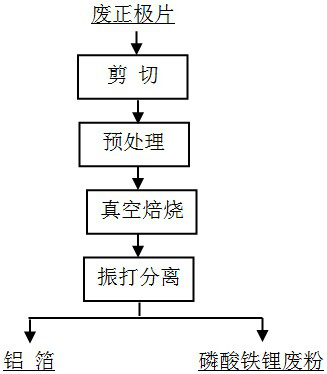A vacuum separation method for the positive electrode sheet of waste lithium iron phosphate battery
A lithium iron phosphate battery, vacuum separation technology, applied in battery recycling, waste collector recycling, recycling technology and other directions, can solve problems such as poor performance of lithium ion batteries, failure to reach lithium iron phosphate products, complex process routes, etc. , to achieve the effect of low processing cost, elimination of pollution and reasonable process
- Summary
- Abstract
- Description
- Claims
- Application Information
AI Technical Summary
Problems solved by technology
Method used
Image
Examples
Embodiment 1
[0032] Step A, cutting: Cut the positive electrode sheet of the waste lithium iron phosphate battery into 30 cm long pieces or strips, and separate them into loose pieces to obtain loose spent electrode sheets.
[0033] Step B, pretreatment: first put loose waste electrode pieces into the vacuum furnace, and then pump the vacuum furnace into a vacuum state, so that the vacuum degree of the vacuum furnace is 0.5.
[0034] Step C. Vacuum roasting: heat up the vacuum furnace at a rate of 12°C per minute for 30 minutes, and keep warm for 6 hours when the temperature reaches 350°C to obtain roasted spent pole pieces.
[0035] Step D, vibration separation: put the calcined waste pole pieces into a vibrating screen with a screen size of 5 mesh in batches, and add 1 kg of steel balls with different diameters between 5-15 mm in diameter for vibration Sieve to obtain aluminum foil and lithium iron phosphate waste powder respectively.
[0036]Through the separation and recovery of waste...
Embodiment 2
[0038] Step A, cutting: Cut the positive electrode sheet of the waste lithium iron phosphate battery into 35 cm long pieces or strips, and separate them into loose shapes.
[0039] Step B, pretreatment: first put loose waste electrode pieces into the vacuum furnace, and then pump the vacuum furnace into a vacuum state, so that the vacuum degree of the vacuum furnace is 0.7.
[0040] Step C. Vacuum roasting: heat up the vacuum furnace at a rate of 20°C per minute for 21 minutes, and keep it warm for 1 hour when the temperature reaches 420°C to obtain roasted spent pole pieces.
[0041] Step D, vibration separation: put the calcined waste pole pieces into a vibrating sieve with a screen mesh of 60 meshes in batches, and add 2 kg of steel balls with different diameters between 5-15 mm in diameter for vibration Sieve to obtain aluminum foil and lithium iron phosphate waste powder respectively.
[0042] Through the separation and recovery of waste lithium iron phosphate positive e...
Embodiment 3
[0044] Step A. Cutting: Cut the positive electrode sheet of the waste lithium iron phosphate battery into a length of 40 cm, and separate it into loose pieces.
[0045] Step B, pretreatment: first put loose waste electrode pieces into the vacuum furnace, and then pump the vacuum furnace into a vacuum state, so that the vacuum degree of the vacuum furnace is 0.9.
[0046] Step C. Vacuum roasting: heat up the vacuum furnace at a rate of 24° C. per minute for 15 minutes. When the temperature reaches 380° C., keep the temperature for 4 hours to obtain roasted spent pole pieces.
[0047] Step D, rapping separation: put the calcined waste pole pieces in batches into a vibrating sieve with a screen mesh of 100 mesh, and add 3 kilograms of steel balls with different particle diameters with diameters between 5-15 mm, and vibrate Sieve to obtain aluminum foil and lithium iron phosphate waste powder respectively.
[0048] Through the separation and recovery of waste lithium iron phospha...
PUM
 Login to View More
Login to View More Abstract
Description
Claims
Application Information
 Login to View More
Login to View More - R&D
- Intellectual Property
- Life Sciences
- Materials
- Tech Scout
- Unparalleled Data Quality
- Higher Quality Content
- 60% Fewer Hallucinations
Browse by: Latest US Patents, China's latest patents, Technical Efficacy Thesaurus, Application Domain, Technology Topic, Popular Technical Reports.
© 2025 PatSnap. All rights reserved.Legal|Privacy policy|Modern Slavery Act Transparency Statement|Sitemap|About US| Contact US: help@patsnap.com

